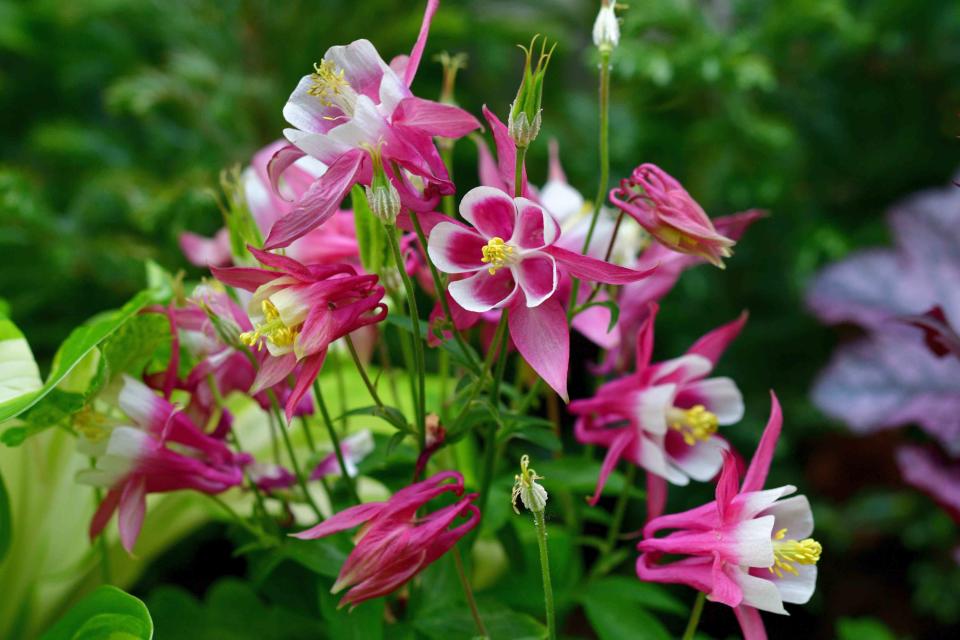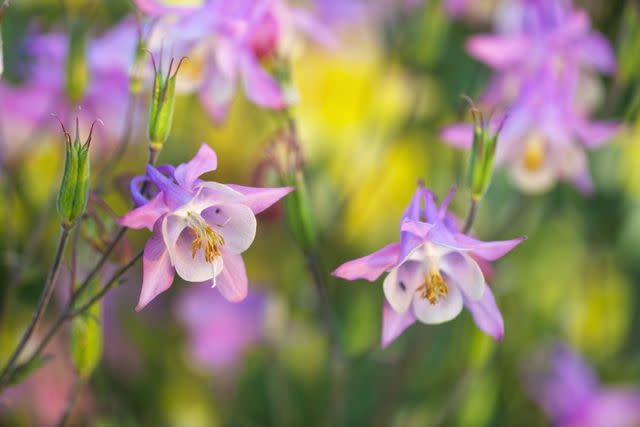How To Grow And Care For Columbine Flowers
If you're looking for a bright and beautiful addition to your garden in the warmer months, check out the columbine flower.

Getty Images
Most columbine plants are cool season, spring-blooming plants with unique flowers. Rising high above the lobed green to gray-green foliage are spikes of flowers, usually facing down with elongated narrow spurs reaching behind. However, there are some varieties that face outward or upwards, do not have spurs, or have double flowers. Available in many colors, columbine plants are ideal for shady wooded areas, but some do well as rock garden plants. They can tolerate a variety of soils like clay, loamy, and sandy, and grow in full sun to partial shade, especially afternoon shade in hotter climates. Plant in early spring or fall. They have a moderate growth rate. The erect, dried brown seed heads are comprised of five capsules that burst open to reveal many dark black small seeds. This plant self-seeds and crosses with other columbine plants. Although a short-lived perennial, the self-sowing makes it appear that the plants last for years in the garden. Columbine flowers attract hummingbirds, butterflies, and hawk moths. The plant is deer resistant and toxic for humans, dogs, and cats if ingested.

Getty Images
Plant Attributes
Common Name | Columbine or Granny’s Bonnet |
Botanical Name | Aquilegia spp. |
Family | Ranunculaceae |
Plant Type | Herbaceous perennial |
Mature Size | 12-36 in. tall, 12-24 in. wide |
Sun Exposure | Partial shade |
Soil Type | Moist but well-drained |
Soil pH | Neutral to slightly acidic |
Bloom Time | Spring, summer |
Flower Color | Red, orange, yellow, blue, purple, pink, white, and green |
Hardiness Zones | 3-8 |
Native Area | North America, Europe, Asia |
Toxicity | Toxic to humans, dogs, and cats |
Columbine Care
Columbine flowers need afternoon shade in hotter climates. They grow in shaded woodlands or sunnier rock gardens in moist, well-drained soil. They don’t like heat so their blooms in spring last through May, and then they die down as summer temperatures rise. They live only a few years, but because they are self-seeding, they continually replenish the garden with new blooms.
They like cooler temperatures and produce more blooms in cooler weather, but their foliage sticks around through the heat of the summer. They grow in USDA Zones 3-8, so choose the best variety for your zone.
Light
Depending on the species, these plants like woodland conditions of partial shade or rock garden conditions of full sun.
Soil
Woodland lovers prefer moist but well drained soil, and very well drained soil keeps those that prefer rock garden conditions happy. Well-drained soil mixed with compost will give them the organic material they like.
Water
Columbines need regular water to keep the soil moist. Allow the top two inches of soil to slightly dry between waterings for many varieties, except for those that like rock garden conditions and require dry soil. Once established, they become fairly drought tolerant and need water once a week.
Temperature and Humidity
Columbines prefer the cool spring temperatures to bloom but their foliage will remain in hot summers. They will produce more flowers in cooler weather.
Fertilizer
No fertilizer is needed.
Types of Columbine Flowers
There are many species in this country and many hybrids/cultivars.
Eastern Red Columbine (Aquilegia canadensis): Relatively tall at 2-3 feet, Eastern red columbine has red and yellow flowers with spurs. It is the only red columbine that occurs in eastern Northern America and is a critical food source for the ruby-throated hummingbird in the spring. The species is resistant to leaf miners. There is a cultivar called 'Little Lanterns' that is more compact at 10 inches high.
Golden Columbine (Aquilegia chrysantha): Although a southwestern native, this plant is highly adaptable and produces yellow flowers with long thin spurs.
Fan Columbine (Aquilegia flabellata): A dwarf plant with purple flowers, fan columbine is perfect for rock gardens. There are varieties of this with white, blue, or pink flowers.
Chocolate Soldier or Green Columbine (Aquilegia viridiflora): These flowers are not solid green—they are either yellow-green or green and dark purple giving them an unusual look, reminiscent of hellebores.
Common Columbine (Aquilegia vulgaris): Within this species there are many cultivars so flowers can be single- or double-petaled and in shades of purple, blue, dark rose, rose, pink, white, and even very dark purple to black.
Pruning
These plants could be trimmed back after flowering in the summer to prevent self-seeding and to rejuvenate the foliage which might be ratty and marred by leaf miners.
Propagating Columbine Flowers
Columbine plants can be propagated by division which is done in the spring. In fact, it is recommended that plants be divided every few years.
Using a garden fork, dig deep along the perimeter of the plant.
Lift up the entire rootstock and place the clump on the ground. No need to remove the soil.
Divide the clump with the garden fork or a sharp knife.
Replant the divisions and keep well-watered until established.
How To Grow Columbine Flowers From Seed
Columbine plants self-seed readily but be aware that this plant can cross with other columbine plants, so if you have different varieties in the garden, the progeny may have different flower colors.
To grow columbine plants from seed, you can let your original plants disperse their seed on their own or you can collect the seed heads. The seed heads are prominent, high above the foliage as inch-long, five-lobed cases. Cut the whole seed heads when they are brown but before they split open and place in a paper bag. Weeks later, when the seed heads have dried even more, split open the casing and remove the seeds.
These seeds need a period of cold stratification—a chilling period—to germinate. When you want to start them, place the seeds in a plastic bag with moist seed starting mix. Place the bag in the fridge for 3-4 weeks. Afterwards, you can start the seeds indoors under lights about 8 weeks before the average last frost or sow directly outside after the last average frost.
Alternatively, sow the seeds in small plastic containers with moist seed starting mix and either put in the fridge, an uncovered cold frame, an unheated porch, or a shed where the temperature remains consistent between 35 to 45 degrees. When the average last frost date has passed, continue to grow outside.
You can also scatter seeds in your garden in the fall and let winter provide the cold stratification.
Commercial seed packets are available. These seeds also need cold stratification.
Potting and Repotting Columbine Flowers
Usually, columbine plants are grown in the garden bed, but they can be grown in containers. Depending on the container size, the plants may be cold hardy enough to come back the next year. Choose a pot with drainage holes and fill with all-purpose potting soil. Plant a seedling in the pot and add a layer of mulch to the top.
Overwintering
These plants die down in the fall and become dormant in the winter. Remove any wilted or dead foliage and cut the plants down to the ground. They will regrow in the spring. Protect the plant from cold winter temperatures with a layer of mulch around the crown.
Common Pests & Plant Diseases
The most common pest is leaf miner. The adults look like small black and yellow flies and the larvae look like yellow maggots, which tunnel their way through the middle of the leaves. This tunneling results in silver or white “doodle” marks on the leaves. This will not kill the plant but makes the foliage unsightly. Remove and trash the leaves that are affected. There are no insecticidal sprays for this. You can plant the Eastern red columbine which is resistant, or you can remove infected leaves.
Another common pest is the columbine sawfly, which appear as green caterpillars that can defoliate the plants. Either pick off the caterpillars by hand or use an insecticidal soap. Columbine aphids are very tiny insects that can stunt the foliage. These can be hosed off with a strong water spray.
Gray mold is a fungus that creates a fuzzy gray mold on the plant. Powdery mildew is a fungus that coats the foliage with a gray or white powder. For these, remove any part as soon as it appears and/or spray with a fungicide.
How To Get Columbine Flowers To Bloom
Columbine flowers bloom for about four weeks in the spring beginning in April through May. Atop tall spikes, small blossoms face downward with long spurs in the back. Some varieties are fragrant, but most do not smell. Sometimes when the plants are started from seed, they will not bloom the first year. Be patient and wait a year. Columbines planted in spring usually bloom the following year. Remove mulch early in the spring, and pinch spent flowers to encourage more buds.
Common Problems with Columbine Flowers
In some ways, columbine plants are easy to grow because they self-seed so you will always have a new generation. In other ways, they can be a challenge if you grow many types and expect them to stay the same in terms of flower color and stay in their place. It is most helpful to understand their growth habit and to simply accept leaf miner damage instead of trying to eradicate leaf miners. Here are a few issues that gardeners notice:
Leaves Turning Yellow
Columbine leaves can turn yellow in dry, hot climates. It is common for them to yellow after blooming. If the plant hasn't bloomed yet, keep the soil consistently moist to see if it corrects. If not, cut the plant down to the crown. It will regrow in spring or possibly when temperatures cool in the fall.
Overcrowding
There are too many plants. Pull the plants when they are small in the spring and then to prevent this, cut off the seed heads when they are green, before they disperse the seeds.
Flower Color
The plants bloomed but the flower color is not what the seed packet says it is. If you have more than one variety in your garden, it is possible that they have crossed pollinated, and the resulting progeny reverted to the flower colors of the grandparents. If you want a particular color, you are going to have to plant only one type or pull those that are the wrong flower color every year until you get a stand of columbine plants with the preferred flower color.
Frequently Asked Questions
Can columbine flowers bloom twice in one season?
After blooming, cut the plant back to the crown to discourage pests. This may also initiate new bloom production for a second display of flowers during the season.
Do hummingbirds like columbines?
Hummingbirds are attracted to brightly colored columbine flowers. They pollinate red flowers, gathering nectar from the blooms as well as the long spurs on the backs of the flowers. Hawk moths generally pollinate yellow and white varieties.
What can I plant with columbine?
Choose plants that require similar sunlight conditions. Plants like hostas, bleeding hearts, coral bells, woodland phlox, and ferns prefer partial shade like columbine.
For more Southern Living news, make sure to sign up for our newsletter!
Read the original article on Southern Living.

